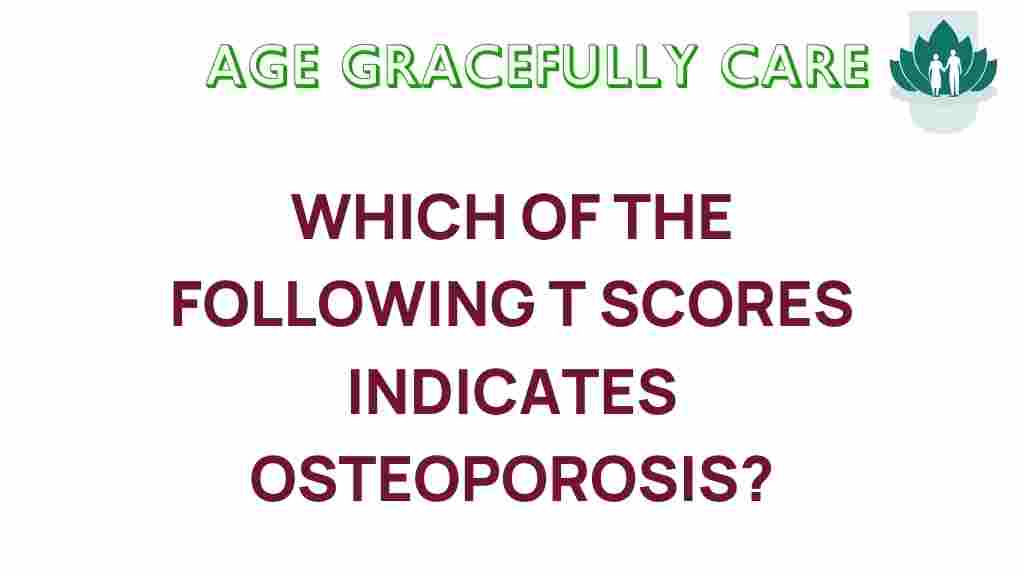Unraveling Osteoporosis: What T Scores Reveal About Bone Health
Osteoporosis is a silent disease that affects millions worldwide, leading to weakened bones and an increased risk of fractures. Understanding your bone health is crucial, and one of the key indicators in this assessment is the T score. In this article, we’ll explore what T scores reveal about osteoporosis, the significance of bone health, and how to address the risk factors, diagnosis, prevention, and treatment of this condition. By raising health awareness, we can empower individuals to take charge of their bone health.
What Are T Scores?
T scores are derived from a bone density test, which measures the mineral content of bones. This test typically assesses the hip and spine, providing a clear picture of bone health. The T score compares your bone density to that of a healthy young adult, indicating how much your bone density deviates from the norm. Understanding T scores is essential for diagnosing osteoporosis and determining the appropriate course of action.
Understanding Osteoporosis
Osteoporosis is characterized by low bone mass and deterioration of bone tissue, leading to increased fragility and risk of fractures. It often progresses without symptoms until a fracture occurs, making awareness and early diagnosis vital. The condition is most prevalent in older adults, particularly postmenopausal women, but it can affect anyone.
The Importance of T Scores in Diagnosis
To diagnose osteoporosis, healthcare professionals use the World Health Organization (WHO) classification based on T scores:
- Normal: A T score of -1.0 or higher
- Low bone mass (osteopenia): A T score between -1.0 and -2.5
- Osteoporosis: A T score of -2.5 or lower
- Severe osteoporosis: A T score of -2.5 or lower with one or more fractures
These classifications help determine the severity of bone loss and guide treatment options. Regular screening is recommended, especially for individuals at higher risk.
Risk Factors for Osteoporosis
Understanding the risk factors for osteoporosis can help in prevention and early intervention. Common risk factors include:
- Age: Bone density decreases as we age.
- Gender: Women are at a higher risk, especially post-menopause.
- Family history: A family history of osteoporosis increases your risk.
- Body frame size: Smaller body frames tend to have less bone mass.
- Lifestyle choices: Sedentary lifestyle, smoking, and excessive alcohol consumption can contribute.
- Medical conditions: Conditions like rheumatoid arthritis, hyperthyroidism, and gastrointestinal disorders can affect bone health.
- Certain medications: Long-term use of corticosteroids and other medications can lead to bone loss.
Preventing Osteoporosis
Prevention is key when it comes to osteoporosis. Here are some effective strategies to improve your bone health and potentially lower your risk:
- Nutrition: Ensure a diet rich in calcium and vitamin D to support bone density. Foods like dairy products, leafy greens, and fortified foods are excellent sources.
- Physical activity: Engage in weight-bearing exercises, such as walking, jogging, or dancing, to strengthen bones.
- Avoid smoking: Quitting smoking can significantly reduce your risk of osteoporosis.
- Limit alcohol intake: Aim for moderation; excessive drinking can lead to bone loss.
- Regular screenings: For those at risk, regular bone density tests can help monitor changes in bone health.
Diagnosis of Osteoporosis
The diagnosis of osteoporosis typically involves a combination of medical history, physical examination, and diagnostic tests. Here’s a step-by-step process:
- Consultation: Discuss your medical history and any risk factors with your healthcare provider.
- Bone density testing: A dual-energy X-ray absorptiometry (DEXA) scan is the most common method used to measure T scores.
- Assessment: Your T score will determine the classification of your bone health.
- Additional tests: Blood tests may be conducted to rule out other conditions affecting bone density.
Treatment Options for Osteoporosis
If diagnosed with osteoporosis, various treatment options are available to enhance bone health and reduce fracture risk:
- Medications: Bisphosphonates are the most common treatment, but other options like hormone therapy or monoclonal antibodies may also be prescribed.
- Calcium and vitamin D supplements: These supplements can help improve bone density.
- Physical therapy: A tailored exercise program can improve strength, balance, and coordination, reducing the risk of falls.
- Lifestyle modifications: Implementing changes to diet and habits can significantly impact bone health.
Medical Insights on Osteoporosis
Recent research has shed light on the complexities of osteoporosis. Medical professionals emphasize the importance of understanding T scores and the role they play in the overall assessment of bone health. Key insights include:
- Genetic factors: Emerging studies suggest that genetics play a significant role in determining individual susceptibility to osteoporosis.
- New treatments: Ongoing research is exploring novel therapeutic options, including anabolic agents that help build new bone.
- Awareness campaigns: Increased health awareness is vital in promoting early detection and prevention strategies.
Troubleshooting Tips for Bone Health
If you’re facing challenges in maintaining or improving your bone health, consider the following troubleshooting tips:
- Evaluate your diet: Ensure you’re getting enough calcium and vitamin D. Consider consulting a nutritionist for personalized advice.
- Stay active: Incorporate physical activities into your daily routine. Even simple exercises can be beneficial.
- Regular check-ups: Schedule regular visits with your healthcare provider to monitor your bone health.
- Educate yourself: Stay informed about osteoporosis and share this knowledge with family and friends to raise health awareness.
Conclusion
Osteoporosis is a significant public health concern, affecting millions and leading to debilitating fractures. Understanding T scores is crucial for diagnosing osteoporosis and assessing bone health. By recognizing the risk factors, pursuing prevention strategies, and exploring treatment options, individuals can take proactive steps to enhance their bone health. Raising health awareness about osteoporosis is essential in empowering people to seek the information and care they need.
For more insights on health and wellness, visit this resource.
By staying informed and taking action, we can all contribute to a healthier future, free from the silent threat of osteoporosis.
This article is in the category Health and created by AgeGracefullyCare Team
